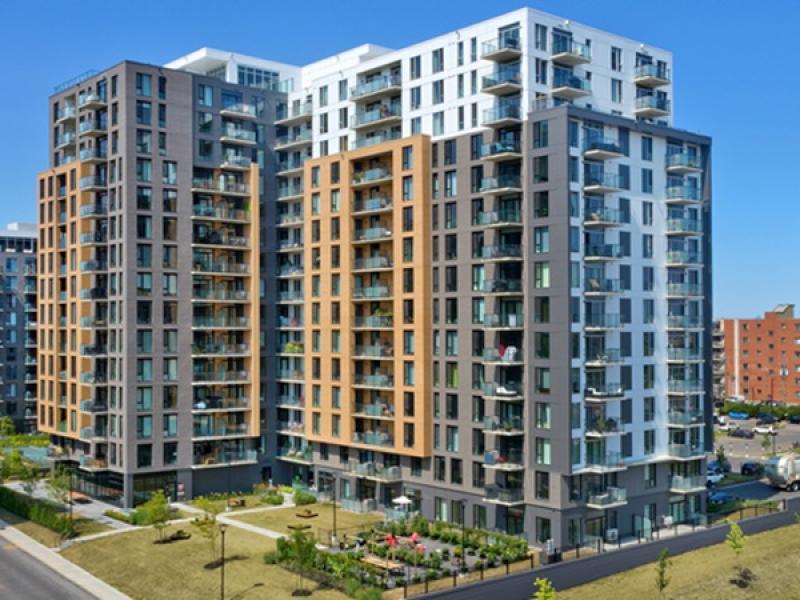
Toronto and Vancouver both experienced positive net absorption of office space in Q1 2025, according to new CBRE data. And in a first since Q1 2020, the national downtown office vacancy rate dipped slightly, led by Toronto and Vancouver.
On the industrial front, CBRE's national data shows a slightly higher availability rate but a pending slowdown in delivery of new capacity to most markets.
Canada's overall office vacancy decreased by 10 basis points to 18.7 per cent, with the downtown rate improving for the first time since the first quarter of 2020, dipping from 20 per cent to 19.9 per cent. Other positive indicators included sublets and construction reaching recent or historic record lows and the average class-A net rent rising to $26.25 per square foot.
On the downside, pre-leasing in buildings under construction is stuck at around 50 per cent nationally despite a general flight to quality. And streaks of positive net absorption ended in Calgary and Edmonton, with both markets posting negative net absorption for the first time in seven and six quarters respectively.
“The office market was poised for a rebound and while there are pockets of positivity, the office market, like much of the economy, is in wait-and-see mode,” said CBRE Canada chairman Paul Morassutti in a statement accompanying the reports.
“It’s unclear how much renewed momentum there is and to what degree tariff-based uncertainty is affecting decision-making. We should have a better idea in the second quarter of what the tariffs really amount to and how businesses will respond.”
The influx of new supply, which had been a factor in rising office vacancy rates, has slowed considerably. There was almost no new supply delivered during Q1 in the major markets, CBRE reports.
Major market office performance
Toronto’s downtown office vacancy declined by 50 basis points, marking the first substantial improvement the market has experienced since before 2020. Market momentum is positive, reflected by a rebound in average asking rates and declining sub-lease space.
The most recent quarter marked the first time since Q2 2021 that Vancouver’s downtown vacancy rate was lower than in the suburbs (10.7 per cent compared to 10.8 per cent), indicating that demand is starting to catch up with new supply.
Tariff threats being imposed on Alberta’s energy exports could pose a hindrance to downtown Calgary’s office occupancy growth in the short-to-medium-term. The tenant base is overwhelmingly comprised of energy and energy-related tenants and uncertainty in the industry could lead to reduced revenues and spending - or the possible exit of some United States-based companies.
While Edmonton began 2025 with 65,000 square feet of negative net absorption, two buildings slated for conversion reduced downtown inventory by 127,000 square feet and aided in keeping vacancy stable at 19.5 per cent. There has been renewed interest in office sales as private investors look to take advantage of attractive pricing.
Ottawa’s office vacancy rate increased from 12.4 to 12.7 per cent. The market remained stable, however, with asking rents in a holding pattern while a gradual mix of new listings and shadow vacancies became active.
The Montreal office market has continued to slow, with downtown accounting for the majority of negative net absorption.
Industrial space absorption is slowing
While net absorption of industrial space remained relatively solid in Q1 and totalled four million square feet nationally, net industrial leasing activity was down from a 10-year quarterly average of six million square feet.
The national industrial availability rate rose by 10 basis points quarter-over-quarter to reach five per cent for the first time since 2016.
Industrial development activity is on track to continue falling, as construction starts dropped to a five-year low of 2.1 million square feet.
“If there is tariff intrigue in the office market, there is existential concern in the industrial market,” Morassutti said in his comments.
“The end of the auto pact and breaking the backbone of the Canadian manufacturing economy is almost too much to contemplate in terms of impacts on market fundamentals. Hopefully this doesn’t come to pass and, if it doesn’t, the industrial market is fundamentally healthy notwithstanding the rise in vacancy.”
Major market industrial performance
Building off the previous quarter’s momentum, net absorption within Toronto’s existing product remained strong and resulted in a 10-basis point decrease in the overall availability rate to 4.6 per cent. The net rental rate was relatively flat quarter-over-quarter.
Increased activity toward the end of the quarter saw net absorption turn positive and availability rates fall to 4.9 per cent in Metro Vancouver. However, declining average asking lease rates and a relatively large speculative construction pipeline continue to impact the market.
Calgary saw no new supply for the first time in five years. Inventory under construction remains low as the market recalibrates following three years with record levels of new development. There’s 1.9 million square feet under construction, well below the five-year average of 4.1 million square feet.
Uncertainty has started to creep into the Edmonton market and resulted in a slow quarter for leasing. Positive net absorption was buoyed by pre-leased new supply deliveries. Availability and vacancy rates increased by 20 and 10 basis points respectively, but remain close to 10-year lows.
Availability remained stable at three per cent as Ottawa rents continued to climb gradually. The majority of product in the development pipeline is large-scale projects, keeping supply for small- and medium-bay space tight despite persistent demand.
There’s 2.4 million square feet of construction in Montreal’s pipeline, with 62.1 per cent of those projects designated as design-build as developers take a cautionary approach to speculative developments.







